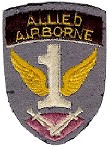First Allied Airborne Army
The First Allied Airborne Army ( German 1st Allied Airborne Army ) was from 1944 to 1945 part of the Allied Armed Forces in northwestern Europe under the command of the Supreme Headquarters Allied Expeditionary Force . It is the largest grouping of airborne forces in history.
history
founding
It was set up on August 2, 1944 . The reason was the experience from the airborne operations in Sicily and Normandy . The aim of the joint high command was closer cooperation between the Army Airborne Forces and the Air Force transport squadrons, as well as better coordination with other units of the Army, Air Force and Navy. This was to avoid situations such as the accidental shooting down of 23 C-47s, which the paratroopers of the 82nd Airborne Division flew in to reinforce the bridgehead in Sicily, by the Allied landing fleet. Throughout its existence, the 1st Allied Airborne Army was commanded by US Lieutenant General Lewis H. Brereton . His deputy was the British Lieutenant General Frederick Browning .
Operations
Before it was founded, units of the 1st Allied Airborne Army had already participated in the fighting in North Africa, Sicily, Italy and France. The most important mission was the landing of the 82nd and 101st US Airborne Divisions and the British 6th Airborne Division on the night of June 5th to 6th, 1944 in the Normandy hinterland. This was part of Operation Neptune , the creation of an Allied beachhead on the Normandy coast.
The first and best-known operation of the 1st Allied Airborne Army was Operation Market Garden , with the army comprising the British I Airborne Corps with the British 1st Airborne Division and the Polish 1 Samodzielna Brygada Spadochronowa as well as the American XVIII Airborne Corps with the 82nd Airborne Division and the 101st Airborne Division to jump over the Netherlands and secure the bridges over several rivers and canals. The XXX. Corps of the British 2nd Army advance and cross the Lower Rhine near Arnhem . The aim of the operation was to bypass the partially heavily fortified Siegfried Line and prevent a closed German defense line along the river by crossing the Rhine . If the operation had been successful, the Allied forces would have been able to advance into Germany from their bridgehead near Arnhem in 1944.
With the start of the German Ardennes offensive , the 17th, 82nd and 101st US Airborne Divisions were relocated to the Ardennes front in Belgium to repel the offensive and helped repel the German attack. The 101st US Airborne Division gained fame here, defending Bastogne for several days against superior German troops until it was detained by General Patton's 4th Armored Division of the 3rd US Army .
The second and final airborne operation of the 1st Allied Airborne Army was Operation Varsity . On March 23, the Allied forces began to cross the Rhine in the vicinity of Wesel . In order to ensure a quick breakthrough through the German defense positions, the British 6th and 17th US airborne divisions landed on the eastern side of the Rhine the following morning and fought down the German defensive positions there - sometimes with heavy losses.
In the weeks that followed, the British and American airborne units advanced along with the ground troops to Germany.
Part of the formation
The 1st Allied Airborne Army comprised:
- XVIII Airborne Corps (USA)
-
I Airborne Corps (UK)
- 1st Airborne Division
- 6th Airborne Division
- 52nd (Lowland) Infantry Division
-
Special Air Service (UK)
- 1st Special Service Brigade (UK)
- 2nd Special Service Brigade (UK)
- 3rd Special Service Brigade ( FFL )
- 4th Special Service Brigade (FFL)
- 5th Special Service Brigade (BE)
- 1 Samodzielna Brygada Spadochronowa ( PSZ )
-
IX Troop Carrier Command ( USAAF )
- 50th Troop Carrier Wing
- 52nd Troop Carrier Wing
- 53rd Troop Carrier Wing
- No. 38 Group ( RAF )
- No. 46 Group (RAF)
Web links
- geocities ( Memento of 28 September 2006 at the Internet Archive () english )

